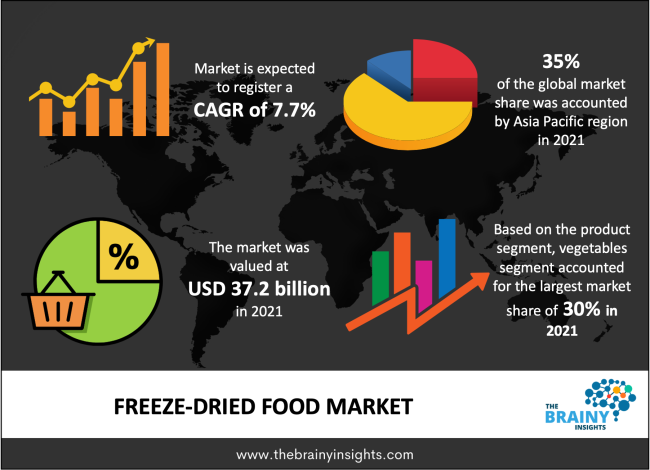
Freeze-Dried Food Market Overview
The freeze-dried food market refers to the industry involved in producing and selling foods that have been processed using freeze-drying technology. This method involves removing the moisture from food while preserving its nutritional content, flavor, and shelf life. Freeze-dried foods are lightweight, portable, and convenient, making them popular for a variety of uses such as in emergency food supplies, outdoor activities, and ready-to-eat meals.
The freeze-dried food market was valued at USD 37.2 billion in 2021 and is projected to grow to USD 71.7 billion by 2030, with a compound annual growth rate (CAGR) of 7.7% from 2022 to 2030.
2. Market Dynamics
- Drivers:
- Growing demand for convenient and long-lasting food products: Consumers are increasingly looking for foods that are easy to store and prepare, especially in situations like camping, hiking, or emergency preparedness.
- Health-conscious consumers: Freeze-drying helps preserve the nutrients and flavors of foods, appealing to those looking for healthier, minimally processed options.
- Technological advancements: The improvement of freeze-drying technologies is making it more efficient and affordable for manufacturers, thus contributing to the market’s growth.
- Restraints:
- High production costs: The freeze-drying process is more expensive than traditional drying methods, which can result in higher prices for consumers.
- Storage and distribution challenges: While freeze-dried foods have a long shelf life, they still require proper storage and distribution conditions to maintain their quality.
- Opportunities:
- Expansion into new regions: As awareness of freeze-dried food benefits grows, new markets, especially in developing countries, present untapped opportunities.
- Innovative product offerings: New product development, such as freeze-dried snacks, fruits, and meal kits, is expanding the market.
- Challenges:
- Consumer education: Not all consumers are familiar with freeze-dried foods, which may limit adoption.
3. Regional Analysis
- North America: The North American region is expected to dominate the market due to the high demand for ready-to-eat meals, particularly in the U.S., where freeze-dried foods are commonly used for outdoor activities and emergency preparedness.
- Europe: Growing demand for natural and convenient food products is driving the market in Europe, with countries like the U.K. and Germany showing notable growth.
- Asia-Pacific: The market is expected to grow rapidly in the Asia-Pacific region, driven by increasing urbanization and changing dietary patterns. Additionally, the rise in the popularity of outdoor activities and travel is contributing to market expansion in countries like China and Japan.
- Latin America and Middle East & Africa: These regions are expected to see moderate growth, driven by increasing awareness of freeze-dried foods, particularly in the context of disaster preparedness and outdoor activities.
4. Segmental Analysis
- By Product Type:
- Fruits & Vegetables: Freeze-dried fruits and vegetables are widely used for snacking, baking, and meal preparation.
- Meals & Snacks: Freeze-dried meals are increasingly popular in the form of complete meals or snacks, especially in outdoor and emergency food sectors.
- Beverages: Freeze-dried coffee, tea, and other beverages are also gaining popularity for their convenience.
- By End-User:
- Residential: The growing trend of meal kits and ready-to-eat foods in households.
- Commercial: Uses include military, healthcare, and foodservice industries where the products need to be portable and long-lasting.
- By Distribution Channel:
- Online Retail: E-commerce platforms are becoming a major sales channel, offering ease of access and convenience for consumers.
- Offline Retail: Includes supermarkets, specialty stores, and direct-to-consumer models.
5. List of Key Players
- Nestlé S.A.
- General Mills, Inc.
- Kirkland Signature (Costco)
- The Hain Celestial Group, Inc.
- Harmony House Foods, Inc.
- FDL Foods Ltd.
- Everest Food Products Pvt. Ltd.
- Mountain House (Oregon Freeze Dry)
- Gourmet Freeze Dried
- Wise Company
6. Key Trends
- Growing demand for plant-based and organic freeze-dried foods: With the increasing focus on health and sustainability, consumers are gravitating toward organic, non-GMO, and plant-based options.
- Use of freeze-dried foods in emergency preparedness: The demand for long shelf-life foods is expanding due to growing concerns over natural disasters and other emergencies.
- Rise in adventure and outdoor activities: Products tailored for outdoor enthusiasts, such as freeze-dried meals and snacks, are gaining popularity.
- Increased use in pet food: Freeze-dried pet foods are becoming popular due to their nutritional value and long shelf life.
7. Request PDF Brochure: https://www.thebrainyinsights.com/enquiry/sample-request/13126
8. Conclusion
The freeze-dried food market is experiencing significant growth driven by consumer demand for convenient, nutritious, and long-lasting food options. The ongoing technological advancements in freeze-drying processes, coupled with growing consumer interest in outdoor activities, emergency preparedness, and healthier eating habits, are expected to further drive market expansion. While there are challenges related to production costs and consumer awareness, the overall outlook for the market remains positive, with opportunities for innovation and regional expansion.
